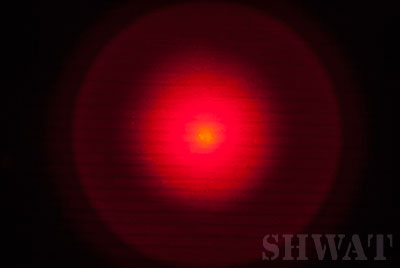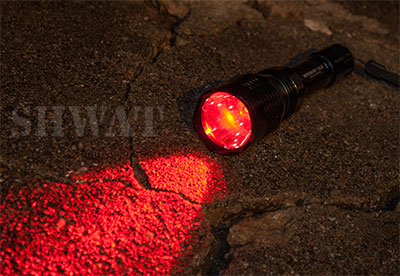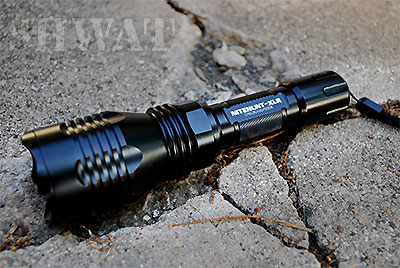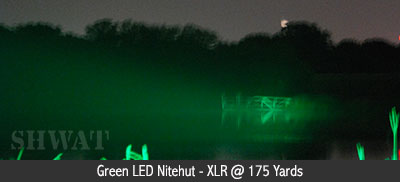
Here in the south where most wild hogs live, it’s getting warmer. The high today at my home is predicted to be 87 degrees. Soon, hunting feral hogs in daylight will be futile in many places. As tactical hog hunters, we will be forced to operate in darkness. We will become like the shadowy figures that names like SHWAT™ conjure up.
At SHWAT™ we are all about using these kinds of gear and tactics. Sometimes it’s the simple things that make for a good hunt though. I still like to go out with my 12 gauge Remington 870 pump shotgun and a flashlight. It’s pure and uncomplicated. However, I still demand that my gear be solid and effective.
We were recently introduced to the Nitehunt line of flashlights. Brandon Moore is the founder of Nighthunt Lights and gave us the run down when we met at the World Predator and Wild Hog Show in Waco, Texas. We’ve talked with Brandon before, and his lights sounded impressive, but until now, we haven’t had the opportunity to try one out. So, now that I have one in hand, I’ll give you the low down on the light and my opinion of whether or not it’s worth the $149.99 price.
Upon opening the box, I see that the XLR System is a complete package. It comes with the light, wall charger, car charger, rechargeable primary battery, rechargeable spare battery, standard pushbutton tail cap switch installed, tape switch, weapon mount, and a red LED in addition to the green LED already installed. It’s all nicely packaged in custom cut closed cell foam. The light is made from aluminum and feels solid in my hand.
 All this is useless if the light doesn’t do its job in the real world. The first thing I do is put both batteries on the charger so I don’t have any issues when I need it. With both batteries full, and the sun down, I head out with the light. The location I chose has a maximum sight distance of 500 yards.
All this is useless if the light doesn’t do its job in the real world. The first thing I do is put both batteries on the charger so I don’t have any issues when I need it. With both batteries full, and the sun down, I head out with the light. The location I chose has a maximum sight distance of 500 yards.
At 260 Lumens (both red and green), the light is definitely bright. The beam pattern has three distinct sections to it. There is a wide circle of light, middle “halo” and a very tight and very bright center. The outer circle provides some peripheral light while the middle halo serves as the main search beam at typical night shooting distances. Once an animal is located, the bright center beam can be used for further identification or to make the shot. If there is too much light for the situation, the light can be easily toggled to 50% brightness by lightly pressing the tail cap switch or power cycling the light.
Here is where the rubber meets the road. Using this hunting light in less than ideal conditions of temperatures in the mid 60s and high humidity, my experience is that animals can be spotted at more than 400 yards with the naked eye. The main limitation of the throw of the light in this case was the humidity. I could see it in the beam of the light. With dryer air, I believe the distance would be greater. Interestingly, running the light on the 50% power gave better clarity in the high humidity. Much like running low beams on your car works better in the fog than high beams.
 In this initial test, I was not able to put my riflescope on any animals. That being said, I believe I could have used a quality optic mounted on a rifle to clearly identify and shoot a hog at more than 300 yards using only the light from the flashlight.
In this initial test, I was not able to put my riflescope on any animals. That being said, I believe I could have used a quality optic mounted on a rifle to clearly identify and shoot a hog at more than 300 yards using only the light from the flashlight.
All my tests were conducted using the pre-installed green LED. I don’t see red as well as most people, so my perception of the red LED could be skewed. It is rated at 260 Lumens just like the green and if you like hunting under red light, it should work in the same way and just as well. There is no conclusive evidence that either color is inherently more effective than the other, but it is commonly said that green may be better for hogs while red may be better for predators. Bill Wilson uses white for hogs. I wouldn’t mind getting the optional white LED for this light myself.
 Regardless of what color you prefer, this is a serious flashlight made for the serious hunter. Is there room for improvement? Yes. I would like to see the weapon mount made of quality aluminum instead of polymer. I would like the ability to power the light on in the 50% mode rather than it always being at full power every time I turn it on. I would also prefer the light to be waterproof instead of water-resistant. However, each of those changes would increase the cost of the light. Would they be worth it? Maybe. But this is a hunting light, not a combat light.
Regardless of what color you prefer, this is a serious flashlight made for the serious hunter. Is there room for improvement? Yes. I would like to see the weapon mount made of quality aluminum instead of polymer. I would like the ability to power the light on in the 50% mode rather than it always being at full power every time I turn it on. I would also prefer the light to be waterproof instead of water-resistant. However, each of those changes would increase the cost of the light. Would they be worth it? Maybe. But this is a hunting light, not a combat light.
I s this light worth $150? Based on my initial test, absolutely. This is one of the best lights on the market at reasonable cost. When you consider all the extras that come in the box, the value gets even better.
s this light worth $150? Based on my initial test, absolutely. This is one of the best lights on the market at reasonable cost. When you consider all the extras that come in the box, the value gets even better.
We’ll keep you posted on how the Nitehunt XLR holds up long term. In the mean time, I’m definitely taking it with me next time I head out with my Remington 870. And likely most any other time I hunt.

